您现在的位置是:首页 >学无止境 >Openai+Deeplearning.AI: ChatGPT Prompt Engineering(五)网站首页学无止境
Openai+Deeplearning.AI: ChatGPT Prompt Engineering(五)
想和大家分享一下最近学习的Deeplearning.AI和openai联合打造ChatGPT Prompt Engineering在线课程.以下是我写的关于该课程的前四篇博客:
ChatGPT Prompt Engineering(一)
ChatGPT Prompt Engineering(二)
ChatGPT Prompt Engineering(三)
ChatGPT Prompt Engineering(四)
今天我们来学习第五部分内容:扩展(Expanding)。
今天我们让ChatGPT成为一个AI助理来帮助人类自主回复客户邮件。首先我们需要设置通过API来访问ChatGPT的主要代码:
import openai
openai.api_key ='YOUR_OPENAI_API_KEY'def get_completion(prompt, model="gpt-3.5-turbo", temperature=0):
messages = [{"role": "user", "content": prompt}]
response = openai.ChatCompletion.create(
model=model,
messages=messages,
temperature=temperature,
)
return response.choices[0].message["content"]自定义对客户电子邮件的自动回复
这里我们会给出一段客户关于商品的负面评论,和一个事先定义好的sentiment等于negative的情绪变量, 然后我们要求ChatGPT根据这段负面评论和情绪变量来写一份客户邮件,以表达对客户的歉意。
#情绪变量
sentiment = "negative"
# 关于搅拌器的客户评论
review = f"""
So, they still had the 17 piece system on seasonal
sale for around $49 in the month of November, about
half off, but for some reason (call it price gouging)
around the second week of December the prices all went
up to about anywhere from between $70-$89 for the same
system. And the 11 piece system went up around $10 or
so in price also from the earlier sale price of $29.
So it looks okay, but if you look at the base, the part
where the blade locks into place doesn’t look as good
as in previous editions from a few years ago, but I
plan to be very gentle with it (example, I crush
very hard items like beans, ice, rice, etc. in the
blender first then pulverize them in the serving size
I want in the blender then switch to the whipping
blade for a finer flour, and use the cross cutting blade
first when making smoothies, then use the flat blade
if I need them finer/less pulpy). Special tip when making
smoothies, finely cut and freeze the fruits and
vegetables (if using spinach-lightly stew soften the
spinach then freeze until ready for use-and if making
sorbet, use a small to medium sized food processor)
that you plan to use that way you can avoid adding so
much ice if at all-when making your smoothie.
After about a year, the motor was making a funny noise.
I called customer service but the warranty expired
already, so I had to buy another one. FYI: The overall
quality has gone done in these types of products, so
they are kind of counting on brand recognition and
consumer loyalty to maintain sales. Got it in about
two days.
"""
#翻译版本
review1="""
因此,他们在11月份仍然以49美元左右的价格出售17套系统,大约是半价,
但由于某种原因(称之为价格欺诈),在12月的第二周左右,同一套系统的价格
都上涨到了70美元到89美元之间。11件套装的价格也从之前的29美元上涨了10美元左右。
所以看起来不错,但如果你看看基地,刀片锁到位的部分看起来不一样从几年前在以前的版本,
但我计划很温柔(示例中,我很努力粉碎物品,如豆类,冰,大米,等搅拌机第一然后粉碎他们的
用量我希望在搅拌机然后切换到细面粉搅拌叶片,并使用交叉刀片首先做冰沙时,然后如果
我需要更细/更少的浆糊,使用平刀片)。制作冰沙时的特别提示,将水果和蔬菜切成细碎
并冷冻(如果用菠菜,稍微炖一下,使菠菜变软,然后冷冻直到可以使用;如果做冰沙,
使用小型到中型的食品加工机),你打算用这种方法来避免在制作冰沙时添加太多的冰。
大约过了一年,发动机发出了一种奇怪的声音。我打电话给客服,但是保修期已经过了,
所以我不得不再买一个。仅供参考:这类产品的整体质量已经不行了,所以
他们依靠品牌认知度和消费者忠诚度来维持销售。大概两天就拿到了。
"""从这段用户评论中我们不难发现客户是在抱怨商品存在质量问题。接下来我们要告诉ChatGPT它的角色是什么(这个很重要),因为只有当ChatGPT知道自己的角色是什么以后,它的回复才会显得更加专业和更有针对性。然后我们要求ChatGPT根据情绪变量的值来做相应的内容回复,如果情绪变量是正面的,则表达感谢,如果情绪变量是负面的则表达歉意,并且在回复客户时需要引用客户评论中的一些细节,以及需要使用简洁和专业的风格来回复客户,最后以“AI客服助理”作为签名。
prompt = f"""
You are a customer service AI assistant.
Your task is to send an email reply to a valued customer.
Given the customer email delimited by ```,
Generate a reply to thank the customer for their review.
If the sentiment is positive or neutral, thank them for
their review.
If the sentiment is negative, apologize and suggest that
they can reach out to customer service.
Make sure to use specific details from the review.
Write in a concise and professional tone.
Sign the email as `AI customer agent`.
Customer review: ```{review}```
Review sentiment: {sentiment}
"""
#翻译版本
prompt1="""
你是一位客服AI助理。
您的任务是向尊贵的客户发送电子邮件回复。
给定由 ``` 分隔的客户电子邮件,
生成回复以感谢客户的评论。
如果情绪是积极的或中立的,感谢他们的评论。
如果情绪是负面的,请道歉并建议他们联系客户服务。
确保使用评论中的具体细节。
以简洁和专业的语气写作。
将电子邮件签名为“AI 客户代理”。
客户评论:```{review}```
评论情绪:{sentiment}
"""
response = get_completion(prompt)
print(response)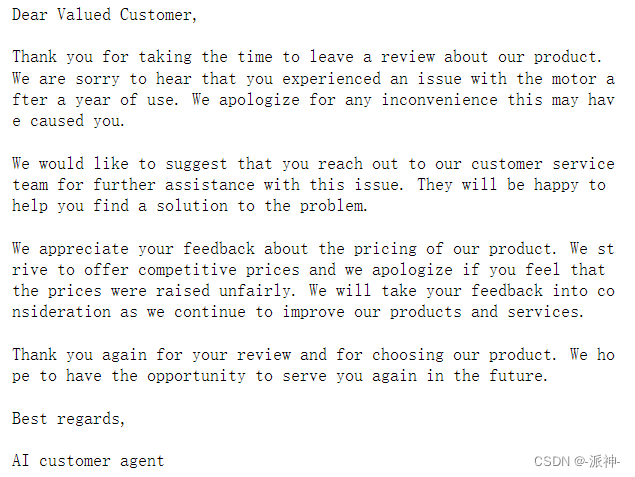
下面是客服AI助理回复email的翻译版本:
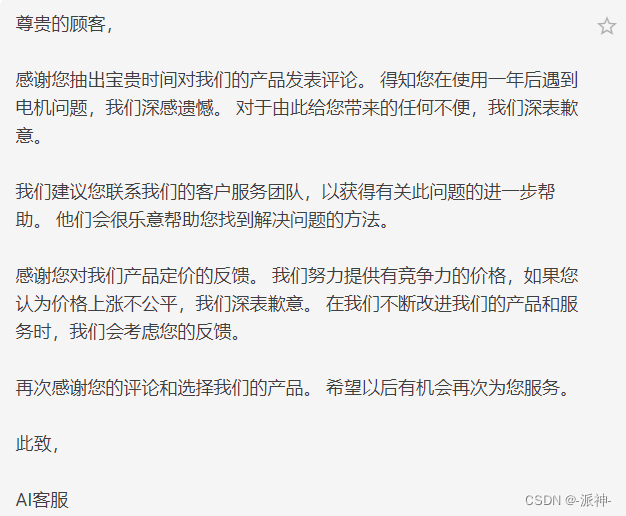
这里我们告知ChatGPT它的角色是:一位客服AI助理,因此ChatGPT的回复将会带有客服AI助理的风格和语气。从回复的内容质量上来看,ChatGPT表现的还是非常的专业,完全按照我们对它的要求来做回复。
提醒模型使用客户电子邮件中的详细信息
我们在调用ChatGPT模型时会使用一个默认温度参数:temperature,该参数的默认值我们把它定义为0,0表示ChatGPT每次只从所有可能的结果中获取一个可能性最高的结果,或者是概率最高的结果。该参数的取值范围为0-1之间,为此我们可以调节temperature参数,temperature的值越大,则回复内容的随机性就越大,反之则随机性越小,因此如果我们想让ChatGPT回复有一定的随机性,可以将temperature值设置为0.5或者0.7,这里我们将temperature设置为0.7,看看ChatGPT的回复和之前有什么差异:
prompt = f"""
You are a customer service AI assistant.
Your task is to send an email reply to a valued customer.
Given the customer email delimited by ```,
Generate a reply to thank the customer for their review.
If the sentiment is positive or neutral, thank them for
their review.
If the sentiment is negative, apologize and suggest that
they can reach out to customer service.
Make sure to use specific details from the review.
Write in a concise and professional tone.
Sign the email as `AI customer agent`.
Customer review: ```{review}```
Review sentiment: {sentiment}
"""
response = get_completion(prompt, temperature=0.7)
print(response) 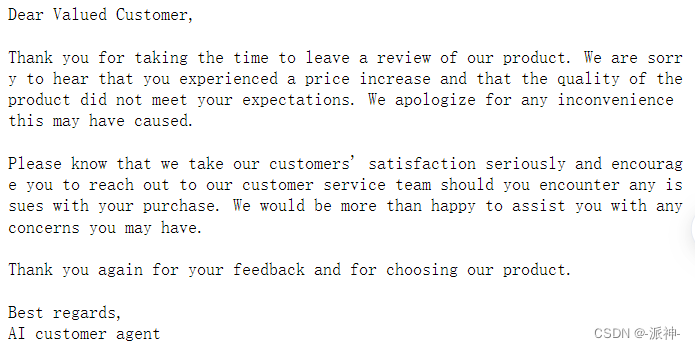
下面我们将该程序执行多次,看看每次回答的差异:

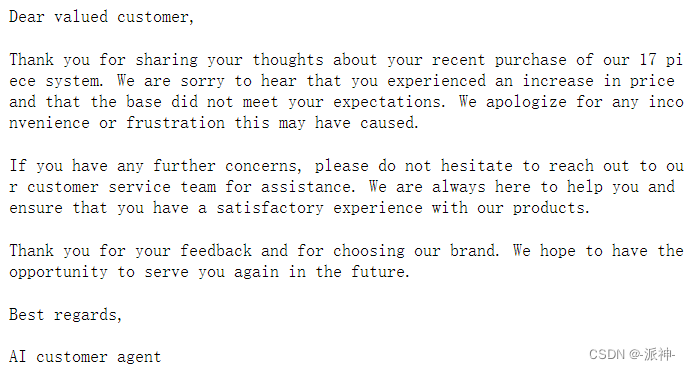
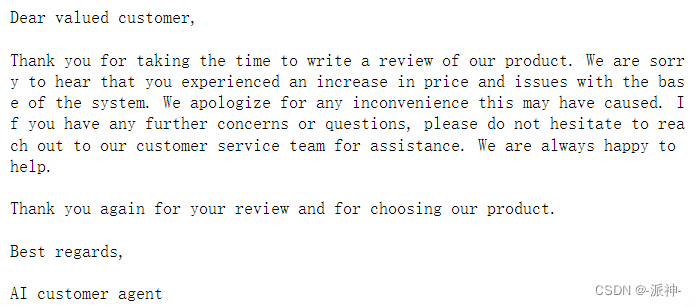
从上面回复的内容上看,ChatGPT每次回复的内容侧重点都有所不同,但主要还是以表达歉意为主要内容,因此如果我们需要让ChatGPT每次回复的时候都有一定的多样性(随机性),那么可以调节温度参数temperature,调高temperature会让回复有更多的随机性。
尝试做一些改变
前面我们的定义了一个情绪变量sentiment=“negative”,那如果我们把sentiment定义为“positive”,结果会怎么样呢?
sentiment = "positive"
prompt = f"""
You are a customer service AI assistant.
Your task is to send an email reply to a valued customer.
Given the customer email delimited by ```,
Generate a reply to thank the customer for their review.
If the sentiment is positive or neutral, thank them for
their review.
If the sentiment is negative, apologize and suggest that
they can reach out to customer service.
Make sure to use specific details from the review.
Write in a concise and professional tone.
Sign the email as `AI customer agent`.
Customer review: ```{review}```
Review sentiment: {sentiment}
"""
response = get_completion(prompt)
print(response)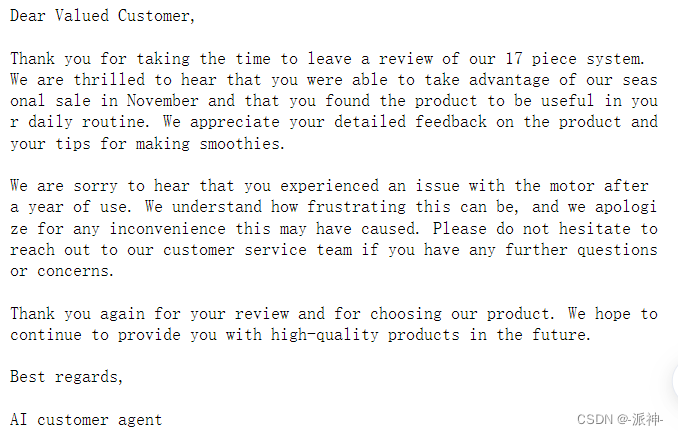
下面是回复翻译版本:

与之前将sentiment定义为“negative”的结果相比,"positive"版的回复多了很多感谢的话语,但同时也提到了产品质量的问题并向客户表达了歉意,从大体上看是正面和反面的话语各占一般,这可能是因为评论本身就是负面的,但是我们又要求ChatGPT以正面的立场来做回复,因此实在是为难ChatGPT了,ChatGPT只能选择部分正面部分是反面的方式来做回复。
接下来我们让ChatGPT来自己识别评论的情绪,然后更加识别的结果来做出回复,这就需要我们修改一下prompt:
prompt = f"""
You are a customer service AI assistant.
Your task is to send an email reply to a valued customer.
Given the customer email delimited by ```,
Generate a reply to thank the customer for their review.
Identify the sentiment of their review,
If the sentiment is positive or neutral, thank them for
their review.
If the sentiment is negative, apologize and suggest that
they can reach out to customer service.
Make sure to use specific details from the review.
Write in a concise and professional tone.
Sign the email as `AI customer agent`.
Customer review: ```{review}```
"""
response = get_completion(prompt)
print(response)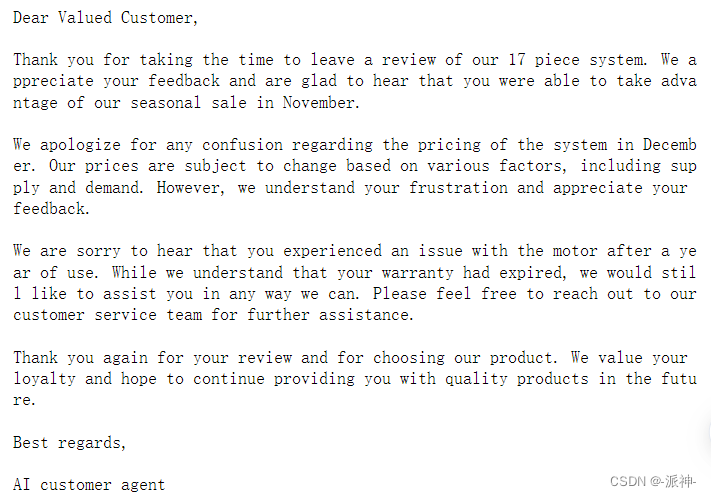
下面是回复的翻译版本:
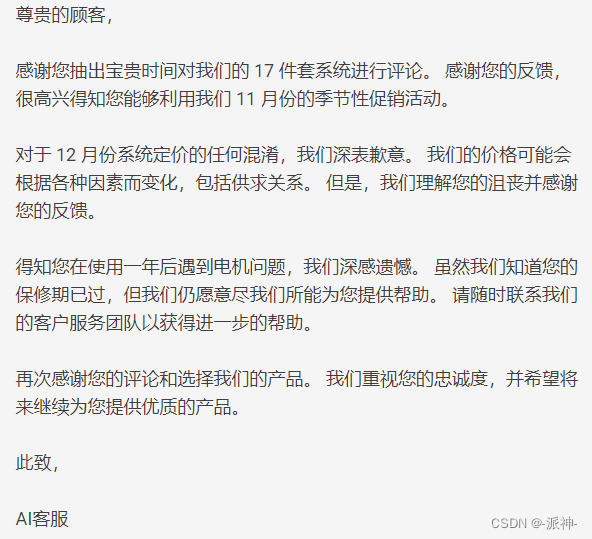
这里我们在prompt中告知ChatGPT要首先识别客户评论中的情绪“Identify the sentiment of their review”,然后根据识别出来的情绪做相应的回复。从ChatGPT回复的内容上看,主要是以表达歉意和道歉为主要内容,这说明ChatGPT已经识别出评论的情绪是负面的,所以回复的内容侧重点在表达歉意上面。
总结
今天我们学习了如果让ChatGPT来代替人类来回复客户邮件,根据客户邮件的内容做出恰当的回复,如果客户评论是正面的,则回复以表达感谢为主,如果客户评论是负面的,则回复以表达歉意为主。同时我们还学习了通过调整temperature参数来使得chatGPT的回复更具多样性(随机性)。





 U8W/U8W-Mini使用与常见问题解决
U8W/U8W-Mini使用与常见问题解决 分享几个国内免费的ChatGPT镜像网址(亲测有效)
分享几个国内免费的ChatGPT镜像网址(亲测有效) stm32使用HAL库配置串口中断收发数据(保姆级教程)
stm32使用HAL库配置串口中断收发数据(保姆级教程) QT多线程的5种用法,通过使用线程解决UI主界面的耗时操作代码,防止界面卡死。...
QT多线程的5种用法,通过使用线程解决UI主界面的耗时操作代码,防止界面卡死。... SpringSecurity实现前后端分离认证授权
SpringSecurity实现前后端分离认证授权